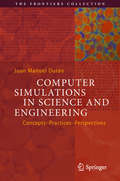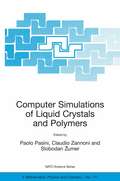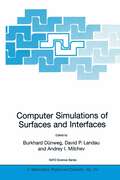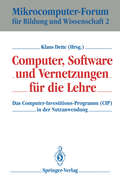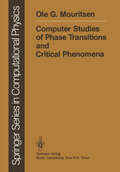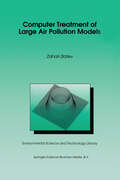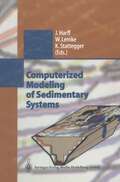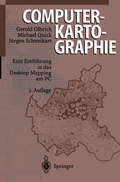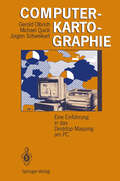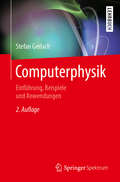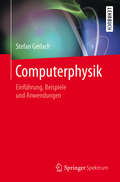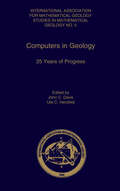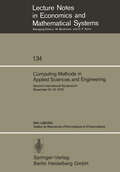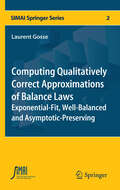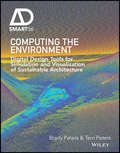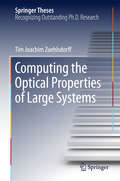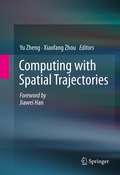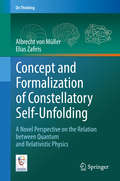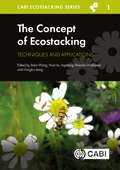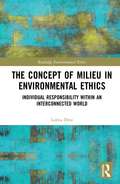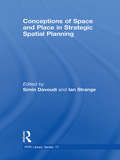- Table View
- List View
Computer Simulations in Science and Engineering: Concepts - Practices - Perspectives (The Frontiers Collection)
by Juan Manuel DuránThis book addresses key conceptual issues relating to the modern scientific and engineering use of computer simulations. It analyses a broad set of questions, from the nature of computer simulations to their epistemological power, including the many scientific, social and ethics implications of using computer simulations. The book is written in an easily accessible narrative, one that weaves together philosophical questions and scientific technicalities. It will thus appeal equally to all academic scientists, engineers, and researchers in industry interested in questions (and conceivable answers) related to the general practice of computer simulations.
Computer Simulations of Liquid Crystals and Polymers: Proceedings of the NATO Advanced Research Workshop on Computational Methods for Polymers and Liquid Crystalline Polymers, Erice, Italy. 16-22 July 2003 (Nato Science Series II: #177)
by Paolo Pasini Slobodan 381 Umer Claudio ZannoniLiquid crystals, polymers and polymer liquid crystals are soft condensed matter systems of major technological and scientific interest. An understanding of the macroscopic properties of these complex systems and of their many and interesting peculiarities at the molecular level can nowadays only be attained using computer simulations and statistical mechanical theories. Both in the Liquid Crystal and Polymer fields a considerable amount of simulation work has been done in the last few years with various classes of models at different special resolutions, ranging from atomistic to molecular and coarse-grained lattice models. Each of the two fields has developed its own set of tools and specialized procedures and the book aims to provide a state of the art review of the computer simulation studies of polymers and liquid crystals. This is of great importance in view of a potential cross-fertilization between these connected areas which is particularly apparent for a number of experimental systems like, e.g. polymer liquid crystals and anisotropic gels where the different fields necessarily merge. An effort has been made to assess the possibilities of a coherent description of the themes that have developed independently, and to compare and extend the theoretical and computational techniques put forward in the different areas.
Computer Simulations of Surfaces and Interfaces (NATO Science Series II: Mathematics, Physics and Chemistry #114)
by Burkhard Dünweg David P. Landau Andrey I. MilchevStudies of surfaces and interactions between dissimilar materials or phases are vital for modern technological applications. Computer simulation methods are indispensable in such studies and this book contains a substantial body of knowledge about simulation methods as well as the theoretical background for performing computer experiments and analyzing the data. The book is self-contained, covering a range of topics from classical statistical mechanics to a variety of simulation techniques, including molecular dynamics, Langevin dynamics and Monte Carlo methods. A number of physical systems are considered, including fluids, magnets, polymers, granular media, and driven diffusive systems. The computer simulation methods considered include both standard and accelerated versions. The simulation methods are clearly related to the fundamental principles of thermodynamics and statistical mechanics.
Computer, Software und Vernetzungen für die Lehre: Das Computer-Investitions-Programm (CIP) in der Nutzanwendung (Mikrocomputer-Forum für Bildung und Wissenschaft #2)
by Klaus DetteComputer Studies of Phase Transitions and Critical Phenomena (Scientific Computation)
by Ole G. University of Southern DenmarkComputer Treatment of Large Air Pollution Models (Environmental Science and Technology Library #2)
by Zahari Zlatev"Models are often the only way of interpreting measurements to in vestigate long-range transport, and this is the reason for the emphasis on them in many research programs". B. E. A. Fisher: "A review of the processes and models of long-range transport of air pollutants", Atmospheric Environment, 17(1983), p. 1865. Mathematical models are (potentially, at least) powerful means in the efforts to study transboundary transport of air pollutants, source-receptor relationships and efficient ways of reducing the air pollution to acceptable levels. A mathematical model is a complicated matter, the development of which is based on the use of (i) various mechanisms describing mathematically the physical and chemical properties of the studied phenomena, (ii) different mathematical tools (first and foremost, partial differenti al equations), (iii) various numerical methods, (iv) computers (especially, high-speed computers), (v) statistical approaches, (vi) fast and efficient visualization and animation techniques, (vii) fast methods for manipulation with huge sets of data (input data, intermediate data and output data).
Computerized Modeling of Sedimentary Systems
by Professor Dr. Jan Harff Dr Wolfram Lemke Professor Dr. Karl StatteggerComputerized modeling is a powerful tool to describe the complex interrelations between measured data and the dynamics of sedimentary systems. Complex interaction of environmental factors with natural variations and increasing anthropogenic intervention is reflected in the sedimentary record at varying scales. The understanding of these processes gives way to the reconstruction of the past and is a key to the prediction of future trends. Especially in cases where observations are limited and/or expensive, computer simulations may substitute for the lack of data. State-of-the-art research work requires a thorough knowledge of processes at the interfaces between atmosphere, hydrosphere, biosphere, and lithosphere, and is therefore an interdisciplinary approach.
Computerkartographie: Eine Einführung in das Desktop Mapping am PC
by Gerold Olbrich Michael Quick Jürgen SchweikartDie Darstellung raumbezogener Daten in Kartenform hat dank der rasanten Entwicklung entsprechender Software stark zugenommen. Immer häufiger bedienen sich heute auch Praktiker und Wissenschaftler, die im Zuge ihrer Ausbildung keine Erfahrung auf dem Gebiet der thematischen Kartographie sammeln konnten, dieser Form der Visualisierung. Ziel dieses Titels ist es daher, dem Leser zunächst unverzichtbares Basiswissen aus dem Bereich der thematischen Kartographie zu vermitteln, um darauf aufbauend die Methodik der angewandten Computerkartographie zu erläutern. Darüber hinaus wird ein Überblick über die Leistungsmerkmale gängiger Software gegeben. Die beiliegende CD-ROM enthält Demoversionen zu den verschiedenen Programmen. Ein Quellenverzeichnis im Anhang führt Bezugsadressen für Koordinatendaten und Software auf.
Computerkartographie: Eine Einführung in das Desktop Mapping am PC
by Gerold Olbrich Michael Quick Jürgen SchweikartEndlich gibt es ein deutschsprachiges Buch, das umfassend die Theorie und Praxis der Computerkartographie darstellt. Es ist verständlich geschrieben, enthält zahlreiche Abbildungen und Beispiele und führt die Leistungsmerkmale gängiger PC-Programme sowie die Bezugsadressen für Koordinatendaten und Software auf.
Computerphysik: Einführung, Beispiele und Anwendungen
by Stefan GerlachDieses Lehrbuch bietet dem Leser eine aktuelle Einführung in das Lösen von physikalischen Problemen mit dem Computer. Die Grundlagen der Computernutzung, der Programmierung sowie der wichtigsten numerischen Methoden werden besprochen und anhand vieler Beispiele und Übungsaufgaben mit zunehmendem Bezug zur Physik verdeutlicht. Die Nutzung des Betriebssystems Linux und die Programmierung in C und Python bilden dabei die Schwerpunkte.Der wichtigste Teil des Buches umfasst die Projekte, in denen die zuvor besprochenen Grundlagen auf unterschiedliche Probleme der Physik angewendet werden. Die Projekte beinhalten viele wichtige Beispiele aus der Computerphysik (u.a. den Oszillator und Anfangswertprobleme) und diskutieren deren Anwendungen im Detail. Der Leser erhält damit das nötige Rüstzeug, um selbstständig physikalische Probleme mithilfe des Computers zu lösen. Zahlreiche Übungsaufgaben unterstützen beim Vertiefen des Erlernten.Neben einer Vielzahl an kleinen Ergänzungen und Verbesserungen ist die zweite Auflage um ein zusätzliches Projektkapitel zum Thema Daten- und Signalanalyse erweitert, wobei wichtige Themen wie statistische Methoden, Filtermethoden und Bildanalyse behandelt werden.Dieses Buch ist in erster Linie für Bachelorstudenten der Physik, aber auch anderer naturwissenschaftlicher Fächer gedacht. Es kann aber auch von Lehrern und Dozenten zur eigenen Vorbereitung genutzt werden. Vorkenntnisse auf dem Gebiet setzt dieses Buch nicht voraus. Nur in den Projekten wird auf Wissen aus den Grundvorlesungen der Physik zurückgegriffen.
Computerphysik: Einführung, Beispiele und Anwendungen
by Stefan GerlachDieses Lehrbuch bietet dem Leser eine aktuelle Einführung in das Lösen von physikalischen Problemen mit dem Computer. Es werden die Grundlagen der Computernutzung, der Programmierung sowie der wichtigsten numerischen Methoden besprochen und anhand vieler Beispiele und Übungsaufgaben mit zunehmendem Bezug zur Physik verdeutlicht. Die Nutzung des Betriebssystems Linux und die Programmierung in C und Python bilden dabei den Schwerpunkt. Der wichtigste Teil des Buches sind die Projekte, in denen die zuvor besprochenen Grundlagen auf unterschiedliche Probleme der Physik angewendet werden. Die Projekte umfassen viele wichtige Beispiele aus der Computerphysik (u.a. den Oszillator und Anfangswertprobleme) und diskutieren deren Anwendungen im Detail. Der Leser erhält damit das nötige Rüstzeug, um selbstständig physikalische Probleme mit Hilfe des Computers zu lösen. Zahlreiche Übungsaufgaben helfen dabei.
Computers in Geology: 25 Years of Progress (International Association for Mathematical Geology Studies in Mathematical Geology)
by John C. Davis Ute Christina HerzfeldThis volume vividly demonstrates the importance and increasing breadth of quantitative methods in the earth sciences. With contributions from an international cast of leading practitioners, chapters cover a wide range of state-of-the-art methods and applications, including computer modeling and mapping techniques. Many chapters also contain reviews and extensive bibliographies which serve to make this an invaluable introduction to the entire field. In addition to its detailed presentations, the book includes chapters on the history of geomathematics and on R.G.V. Eigen, the "father" of mathematical geology. Written to commemorate the 25th anniversary of the International Association for Mathematical Geology, the book will be sought after by both practitioners and researchers in all branches of geology.
Computing Methods in Applied Sciences and Engineering: Second International Symposium December 15–19, 1975 (Lecture Notes in Economics and Mathematical Systems #134)
by J. L. Lions R. GlowinskiIRIA LABORIA, Institut de Recherche d'Informatique et d'Automatique
Computing Qualitatively Correct Approximations of Balance Laws: Exponential-Fit, Well-Balanced and Asymptotic-Preserving (SEMA SIMAI Springer Series #2)
by Laurent GosseSubstantial effort has been drawn for years onto the development of (possibly high-order) numerical techniques for the scalar homogeneous conservation law, an equation which is strongly dissipative in L1 thanks to shock wave formation. Such a dissipation property is generally lost when considering hyperbolic systems of conservation laws, or simply inhomogeneous scalar balance laws involving accretive or space-dependent source terms, because of complex wave interactions. An overall weaker dissipation can reveal intrinsic numerical weaknesses through specific nonlinear mechanisms: Hugoniot curves being deformed by local averaging steps in Godunov-type schemes, low-order errors propagating along expanding characteristics after having hit a discontinuity, exponential amplification of truncation errors in the presence of accretive source terms... This book aims at presenting rigorous derivations of different, sometimes called well-balanced, numerical schemes which succeed in reconciling high accuracy with a stronger robustness even in the aforementioned accretive contexts. It is divided into two parts: one dealing with hyperbolic systems of balance laws, such as arising from quasi-one dimensional nozzle flow computations, multiphase WKB approximation of linear Schrödinger equations, or gravitational Navier-Stokes systems. Stability results for viscosity solutions of onedimensional balance laws are sketched. The other being entirely devoted to the treatment of weakly nonlinear kinetic equations in the discrete ordinate approximation, such as the ones of radiative transfer, chemotaxis dynamics, semiconductor conduction, spray dynamics or linearized Boltzmann models. “Caseology” is one of the main techniques used in these derivations. Lagrangian techniques for filtration equations are evoked too. Two-dimensional methods are studied in the context of non-degenerate semiconductor models.
Computing the Environment: Digital Design Tools for Simulation and Visualisation of Sustainable Architecture (AD Smart)
by Brady Peters Terri PetersComputing the Environment presents practical workflows and guidance for designers to get feedback on their design using digital design tools on environmental performance. Starting with an extensive state-of-the-art survey of what top international offices are currently using in their design projects, this book presents detailed descriptions of the tools, algorithms, and workflows used and discusses the theories that underlie these methods. Project examples from Transsolar Klimaengineering, Buro Happold´s SMART Group, Behnish Behnisch Architects, Thomas Herzog, Autodesk Research are contextualized with quotes and references to key thinkers in this field such as Eric Winsberg, Andrew Marsh, Michelle Addington and Ali Malkawi.
Computing the Environment: Digital Design Tools for Simulation and Visualisation of Sustainable Architecture (AD Smart)
by Brady Peters Terri PetersComputing the Environment presents practical workflows and guidance for designers to get feedback on their design using digital design tools on environmental performance. Starting with an extensive state-of-the-art survey of what top international offices are currently using in their design projects, this book presents detailed descriptions of the tools, algorithms, and workflows used and discusses the theories that underlie these methods. Project examples from Transsolar Klimaengineering, Buro Happold´s SMART Group, Behnish Behnisch Architects, Thomas Herzog, Autodesk Research are contextualized with quotes and references to key thinkers in this field such as Eric Winsberg, Andrew Marsh, Michelle Addington and Ali Malkawi.
Computing the Optical Properties of Large Systems (Springer Theses)
by Tim Joachim ZuehlsdorffThis work addresses the computation of excited-state properties of systems containing thousands of atoms. To achieve this, the author combines the linear response formulation of time-dependent density functional theory (TDDFT) with linear-scaling techniques known from ground-state density-functional theory. This extends the range of TDDFT, which on its own cannot tackle many of the large and interesting systems in materials science and computational biology. The strengths of the approach developed in this work are demonstrated on a number of problems involving large-scale systems, including exciton coupling in the Fenna-Matthews-Olson complex and the investigation of low-lying excitations in doped p-terphenyl organic crystals.
Computing with Spatial Trajectories
by Yu Zheng Xiaofang ZhouSpatial trajectories have been bringing the unprecedented wealth to a variety of research communities. A spatial trajectory records the paths of a variety of moving objects, such as people who log their travel routes with GPS trajectories. The field of moving objects related research has become extremely active within the last few years, especially with all major database and data mining conferences and journals. Computing with Spatial Trajectories introduces the algorithms, technologies, and systems used to process, manage and understand existing spatial trajectories for different applications. This book also presents an overview on both fundamentals and the state-of-the-art research inspired by spatial trajectory data, as well as a special focus on trajectory pattern mining, spatio-temporal data mining and location-based social networks. Each chapter provides readers with a tutorial-style introduction to one important aspect of location trajectory computing, case studies and many valuable references to other relevant research work. Computing with Spatial Trajectories is designed as a reference or secondary text book for advanced-level students and researchers mainly focused on computer science and geography. Professionals working on spatial trajectory computing will also find this book very useful.
Concept and Formalization of Constellatory Self-Unfolding: A Novel Perspective on the Relation between Quantum and Relativistic Physics (On Thinking)
by Albrecht Von Müller Elias ZafirisThis volume offers a fundamentally different way of conceptualizing time and reality. Today, we see time predominantly as the linear-sequential order of events, and reality accordingly as consisting of facts that can be ordered along sequential time. But what if this conceptualization has us mistaking the “exhausts” for the “real thing”, i.e. if we miss the best, the actual taking place of reality as it occurs in a very differently structured, primordial form of time, the time-space of the present? In this new conceptual framework, both the sequential aspect of time and the factual aspect of reality are emergent phenomena that come into being only after reality has actually taken place. In the new view, facts are just the “traces” that the actual taking place of reality leaves behind on the co-emergent “canvas’’ of local spacetime. Local spacetime itself emerges only as facts come into being – and only facts can be adequately localized in it. But, how does reality then actually occur? It is conceived as a “constellatory self-unfolding”, characterized by strong self-referentiality, and taking place in the primordial form of time, the not yet sequentially structured “time-space of the present”. Time is seen here as an ontophainetic platform, i.e. as the stage on which reality can first occur. This view of time (and, thus, also space) seems to be very much in accordance with what we encounter in quantum physics before the so-called collapse of the wave function. In parallel, classical and relativistic physics largely operate within the factual portrait of reality, and the sequential aspect of time, respectively. Only singularities constitute an important exemption: here the canvas of local spacetime – that emerged together with factization – melts down again. In the novel framework quantum reduction and singularities can be seen and addressed as inverse transitions: In quantum physical state reduction reality “gains” the chrono-ontological format of facticity, and the sequential aspect of time becomes applicable. In singularities, by contrast, the inverse happens: Reality loses its local spacetime formation and reverts back into its primordial, pre-local shape – making in this way the use of causality relations, Boolean logic and the dichotomization of subject and object obsolete. For our understanding of the relation between quantum and relativistic physics this new view opens up fundamentally new perspectives: Both are legitimate views of time and reality, they just address very different chrono-ontological portraits, and thus should not lead us to erroneously subjugating one view under the other. The task of the book is to provide a formal framework in which this radically different view of time and reality can be addressed properly. The mathematical approach is based on the logical and topological features of the Borromean Rings. It draws upon concepts and methods of algebraic and geometric topology – especially the theory of sheaves and links, group theory, logic and information theory, in relation to the standard constructions employed in quantum mechanics and general relativity, shedding new light on the pestilential problems of their compatibility. The intended audience includes physicists, mathematicians and philosophers with an interest in the conceptual and mathematical foundations of modern physics.
The Concept of Ecostacking: Techniques and Applications (Ecostacking Series)
by Heikki M.T. Hokkanen Dr Ingeborg Menzler-Hokkanen James D Blande Fanny Boerave Dr Daniel Carrillo Tomislav Cernava Xiaoyulong Chen Wen-Qiang Chu Gloria Gauthura Severin Hatt Jarmo K Holopainen Fathiya Khamis Pål Kvello Guang-Yun Li Dr Yaying Li Beatrice Muriithi Jinzhi Niu Levi Ombura Xian Wang Ziying Wang Qiu Yang Wei Yixia Wu Li Ya-Ying Kaijun ZhangEcostacking is a new concept and approach which aims to maximize the benefits of ecosystem service providers in cropping systems to help achieve the goal of long-term sustainable agriculture and food production. The term "ecostacking" means combining synergistically the beneficial services of functional biodiversity from all levels and types. It is a comprehensive approach, where the various ecosystem service providers are fully integrated with the rest of the cropping system including agronomic practices. It is an approach which goes beyond conventional Integrated Pest Management practises, and attempts to take advantage of all the functional biodiversity of a system. The main focus of ecostacking is on maximizing ecosystem services for biological control and pollination from beneficial arthropods, but the approach also utilizes other invertebrates (e.g., earthworms) as well as beneficial vertebrates such as bats, birds and small mammals. Microbes also provide invaluable ecosystem services including pest, disease, and weed control, either directly as components of "suppressive soils" or as plant colonizers (as endophytes or as epiphytic microbial flora). The ecostacking approach also aims to maximize other nature-provided services such as maintenance of soil health and nutrient cycling. The Concept of Ecostacking is the first book in a series which introduces ecostacking concepts to the reader and explores how this approach can be used in a variety of ways and in different cropping systems. The book defines this new concept and shows, using illustrative case studies from around the world, how ecostacking principles can be successfully employed in cropping systems in the open field, in greenhouses and in forestry. This book: · will serve as inspiration for developing further applications of this breakthrough technology for sustainable agricultural production. · is a must-read for everyone with an interest in developing sustainable crop protection systems and ecosystem management. · has been written and edited by the world's leading experts in this new and exciting endeavour.
The Concept of Milieu in Environmental Ethics: Individual Responsibility within an Interconnected World (Routledge Environmental Ethics)
by Laÿna DrozThe Concept of Milieu in Environmental Ethics discusses how we can come together to address current environmental problems at the planetary level, such as climate change, biodiversity loss, transborder pollution and desertification. The book recognises the embedded individual sociocultural and environmental contexts that impact our everyday choices. It asks, in this pluralism of worldviews, how can we build common ground to tackle environmental issues? What is our individual moral responsibility within the larger collaborative challenge? Through philosophical reasoning, this book pragmatically addresses these questions and builds a framework to support sustainable ways of living. At the core of the book, it draws on the concept of milieu (fūdo) inspired by the Japanese philosopher Watsuji Tetsurō, which captures how we act within and perceive our surroundings as a web of culturally, historically and geographically situated meanings and values. It argues that the milieu connects us as individuals with community, past and future history, and the natural world, providing us with common ground for global environmental ethics. This book will be an engaging and interesting read for scholars, researchers and students in environmental ethics, philosophy and sustainability.
The Concept of Milieu in Environmental Ethics: Individual Responsibility within an Interconnected World (Routledge Environmental Ethics)
by Laÿna DrozThe Concept of Milieu in Environmental Ethics discusses how we can come together to address current environmental problems at the planetary level, such as climate change, biodiversity loss, transborder pollution and desertification. The book recognises the embedded individual sociocultural and environmental contexts that impact our everyday choices. It asks, in this pluralism of worldviews, how can we build common ground to tackle environmental issues? What is our individual moral responsibility within the larger collaborative challenge? Through philosophical reasoning, this book pragmatically addresses these questions and builds a framework to support sustainable ways of living. At the core of the book, it draws on the concept of milieu (fūdo) inspired by the Japanese philosopher Watsuji Tetsurō, which captures how we act within and perceive our surroundings as a web of culturally, historically and geographically situated meanings and values. It argues that the milieu connects us as individuals with community, past and future history, and the natural world, providing us with common ground for global environmental ethics. This book will be an engaging and interesting read for scholars, researchers and students in environmental ethics, philosophy and sustainability.
Conceptions of Space and Place in Strategic Spatial Planning (RTPI Library Series)
by Simin Davoudi Ian StrangeBringing together authors from academia and practice, this book examines spatial planning at different places throughout the British Isles. Six illustrative case studies of practice examine which conceptions of space and place have been articulated, presented and visualized through the production of spatial strategies. Ranging from a large conurbation (London) to regional (Yorkshire and Humber) and national levels, the case studies give a rounded and grounded view of the physical results and the theory behind them. While there is widespread support for re-orienting planning towards space and place, there has been little common understanding about what constitutes ‘spatial planning’, and what conceptions of space and place underpin it. This book addresses these questions and stimulates debate and critical thinking about space and place among academic and professional planners.
Conceptions of Space and Place in Strategic Spatial Planning (RTPI Library Series)
by Simin Davoudi Ian StrangeBringing together authors from academia and practice, this book examines spatial planning at different places throughout the British Isles. Six illustrative case studies of practice examine which conceptions of space and place have been articulated, presented and visualized through the production of spatial strategies. Ranging from a large conurbation (London) to regional (Yorkshire and Humber) and national levels, the case studies give a rounded and grounded view of the physical results and the theory behind them. While there is widespread support for re-orienting planning towards space and place, there has been little common understanding about what constitutes ‘spatial planning’, and what conceptions of space and place underpin it. This book addresses these questions and stimulates debate and critical thinking about space and place among academic and professional planners.
